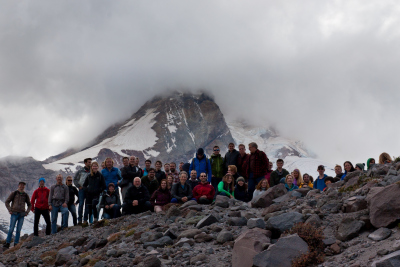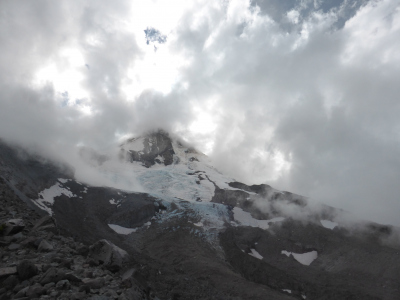Page path:
Thomas Lorscheid
Report of GLOMAR PhD student Thomas Lorscheid about his participation in the PALSEA 2016 Meeting in Oregon, USA from 18 - 21 September 2016
The PALSEA (PALeo constraints on SEA level rise) meetings are held every year since 2008 in the framework of an international focus group funded by INQUA (International Union for Quaternary Research) and PAGES (Past Global Changes). This working group aims on a better understanding of the changes in paleo sea level and ice-sheet configuration to better project future sea-level rise. The meetings of this group are intended to present the participants current research and some keynote lectures, as well as organize common projects and start collaborations. This year around 60 participants met in the Timberline Lodge (also an U.S. National Historic Landmark) at Mount Hood, Oregon, USA from the 18-21 September 2016.
The workshop was divided in four sessions per day, usually containing three presentations each. Generally the topics of the talks became older in age, starting with the sea-level rise in the common era, followed by the Holocene deglaciation and the LGM and finally leading to the last interglacial sea-level. Several invited speakers from different field gave keynote lectures and a poster session was held on the evening of the first day. Also a fieldtrip was organized on the second afternoon to the Elliot Glacier on the other side of Mount Hood. Personally, I could present a poster on the ideas for my upcoming work on differences in using the last interglacial sea level as an indicator for tectonic uplift/subsidence, as well as some contents of my first part of my thesis project about the meaning of beach deposits a sea-level indicators.
Preceded was the workshop by a small half-day meeting of the HOLSEA sub-group on the 17 September 2016 that aims the creation of a global Holocene sea-level database. The HOLSEA meeting consisted of several presentation on common sea-level indicators and the current state of the database. It ended with a longer discussion on the needs for a common structure for the regional databases and on the spatial distribution of available data and how the gaps can be filled.
Both meetings were topically very focused and therefore helpful to understand the current status of sea-level research in a broader framework. Also the combination of the data collectors with the modelers in both the sea-level and the ice-sheet distribution is a good approach to become a better overall picture of the interactions of both processes. Due to the relatively small amount of people and the extraordinary, remote location, where the participants were also accommodated, the flair was very open and friendly. This lead to several new contacts and ideas for future cooperation.
For giving me the possibility to attend this meeting, I would like to thank the University of Bremen, the German Excellence Initiative and ZMT for the financial support.
The workshop was divided in four sessions per day, usually containing three presentations each. Generally the topics of the talks became older in age, starting with the sea-level rise in the common era, followed by the Holocene deglaciation and the LGM and finally leading to the last interglacial sea-level. Several invited speakers from different field gave keynote lectures and a poster session was held on the evening of the first day. Also a fieldtrip was organized on the second afternoon to the Elliot Glacier on the other side of Mount Hood. Personally, I could present a poster on the ideas for my upcoming work on differences in using the last interglacial sea level as an indicator for tectonic uplift/subsidence, as well as some contents of my first part of my thesis project about the meaning of beach deposits a sea-level indicators.
Preceded was the workshop by a small half-day meeting of the HOLSEA sub-group on the 17 September 2016 that aims the creation of a global Holocene sea-level database. The HOLSEA meeting consisted of several presentation on common sea-level indicators and the current state of the database. It ended with a longer discussion on the needs for a common structure for the regional databases and on the spatial distribution of available data and how the gaps can be filled.
Both meetings were topically very focused and therefore helpful to understand the current status of sea-level research in a broader framework. Also the combination of the data collectors with the modelers in both the sea-level and the ice-sheet distribution is a good approach to become a better overall picture of the interactions of both processes. Due to the relatively small amount of people and the extraordinary, remote location, where the participants were also accommodated, the flair was very open and friendly. This lead to several new contacts and ideas for future cooperation.
For giving me the possibility to attend this meeting, I would like to thank the University of Bremen, the German Excellence Initiative and ZMT for the financial support.





